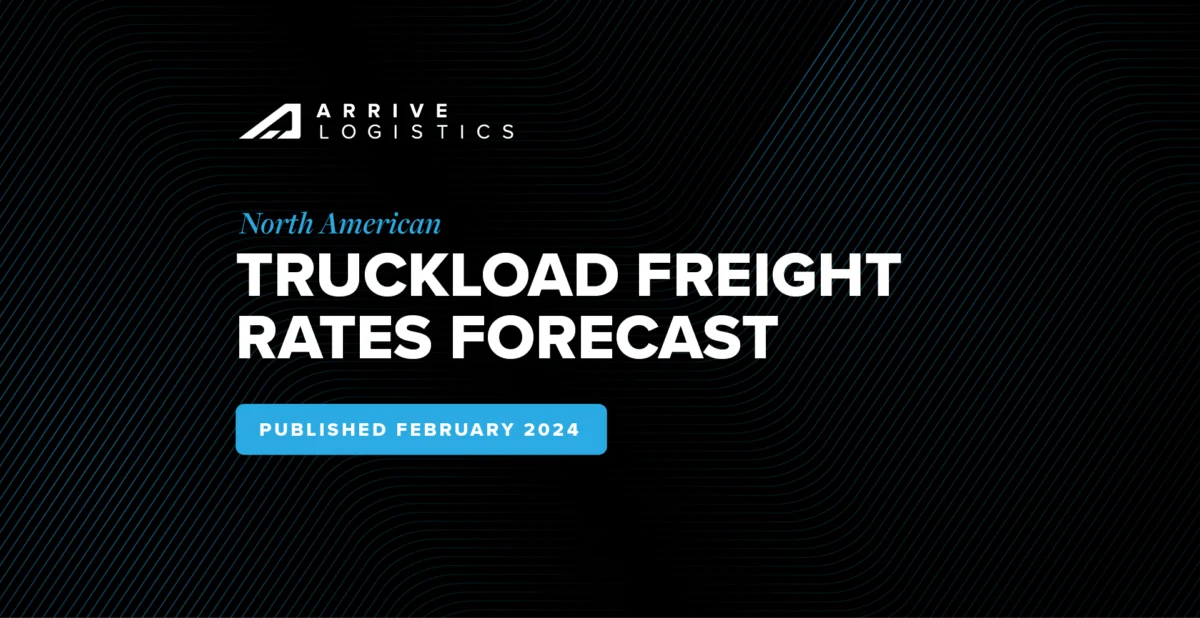
"*" indicates required fields
"*" indicates required fields
"*" indicates required fields

This document contains our comprehensive outlook for national dry van and reefer truckload rates through December 2024. The Arrive Insights® team generated this forecast through a combination of extensive historical research and output from the predictive models built into ARRIVEnow, our proprietary technology platform.
Successfully navigating freight market ebbs and flows begins with a basic understanding of the relationship between rates and the unique components of truckload supply and demand. Simply put, high or increasing demand and tight capacity will cause upward rate pressure, whereas low or easing demand and ample available capacity will drive rates down.
By tracking directional trends for truckload demand (volume) and available capacity (trucks) in the market at any given time, we can predict rate trends with a high degree of accuracy and consistency.
We anticipate the spot rate floor increasing as 2024 progresses, resetting higher through periods of seasonal volatility. Contract rates will continue to normalize, but fall at a slower rate than in 2023, finding a floor sometime in Q2 or Q3. A shrinking contract-spot rate gap will increase the market’s vulnerability to significant disruption. However, any major disruption will likely require a black swan event or other catalyst, making predicting the exact timing of a major shift very difficult.
Freight tonnage is unlikely to give trucking conditions a meaningful boost, however, a resetting inventory cycle should help support flat to slow demand growth. Downside risk remains as economic conditions normalize toward pre-pandemic levels.
The market remains oversupplied but will become increasingly vulnerable to disruption as the year progresses.
This forecast outlines what we believe will be the most likely scenario given the information available at the time of writing. Upside risk and downside risk scenarios are illustrated as part of the forecast and can be realized as a result of unforeseen events, including but not limited to the following.
The wars in Europe and the Middle East, as well as the threat of attacks in the Red Sea, are all risks that have impacted global trade, and could continue to do so for the foreseeable future. Similarly, tensions between China and Taiwan could impact Asia-U.S. relations and trade, including Taiwan’s prominent semiconductor production.
Although a recession is likely off the table in the short term, uncertainty for economic conditions remains. Effects from elevated inflation and interest rates are still materializing and could cause conditions to worsen faster than expected, resulting in declining trucking demand due to dwindling consumer demand and manufacturing pullbacks.
Severe weather is a frequent source of freight market disruption. Winter storms early in Q1 had a recognizable impact and could be a foreshadowing for future weather-related disruptions. Additionally, drought in the Panama Canal region is impacting global trade flows, which could lead to a shift in import ports of entry.
Spot rates continue to persist below public truckload carriers’ operating cost per mile for most of the past year. When this occurs, it usually isn’t long before spot rates rebound or experience some upward pressure because rates can only fall so far before carriers start to lose money and decide to sit out or leave the market entirely. This scenario creates a floor for rates and is why our forecasted spot rates typically trend to the downside. With capacity exiting the market, spot rates will likely continue to see a floor reset higher after each period of seasonal volatility.
A factor that has now had impacts on the forecast trends due to volatility in both directions, rapidly changing fuel surcharges can make measuring forecast errors more complex. They can also create different behavioral profiles for shippers and carriers in the marketplace. For example, rapidly declining fuel costs drive more favorable conditions for carriers and alleviate pressure on shippers looking for cost reductions. As of late, fuel has stabilized, but over the past 24 months, we have redefined what fuel price volatility looks like.
The national average spot rate per mile and the national average contract rate per mile are values sourced from DAT and undergo no additional processing. However, at times, DAT executes updates to previously published rates, which can lead to variations in what we report vs. what is accessible through materials published directly by DAT.
Our goal is to set reasonable expectations for directional rate movements of the national average spot and contract rates published by DAT, based on the macroeconomic factors impacting supply and demand in the domestic truckload freight market.

